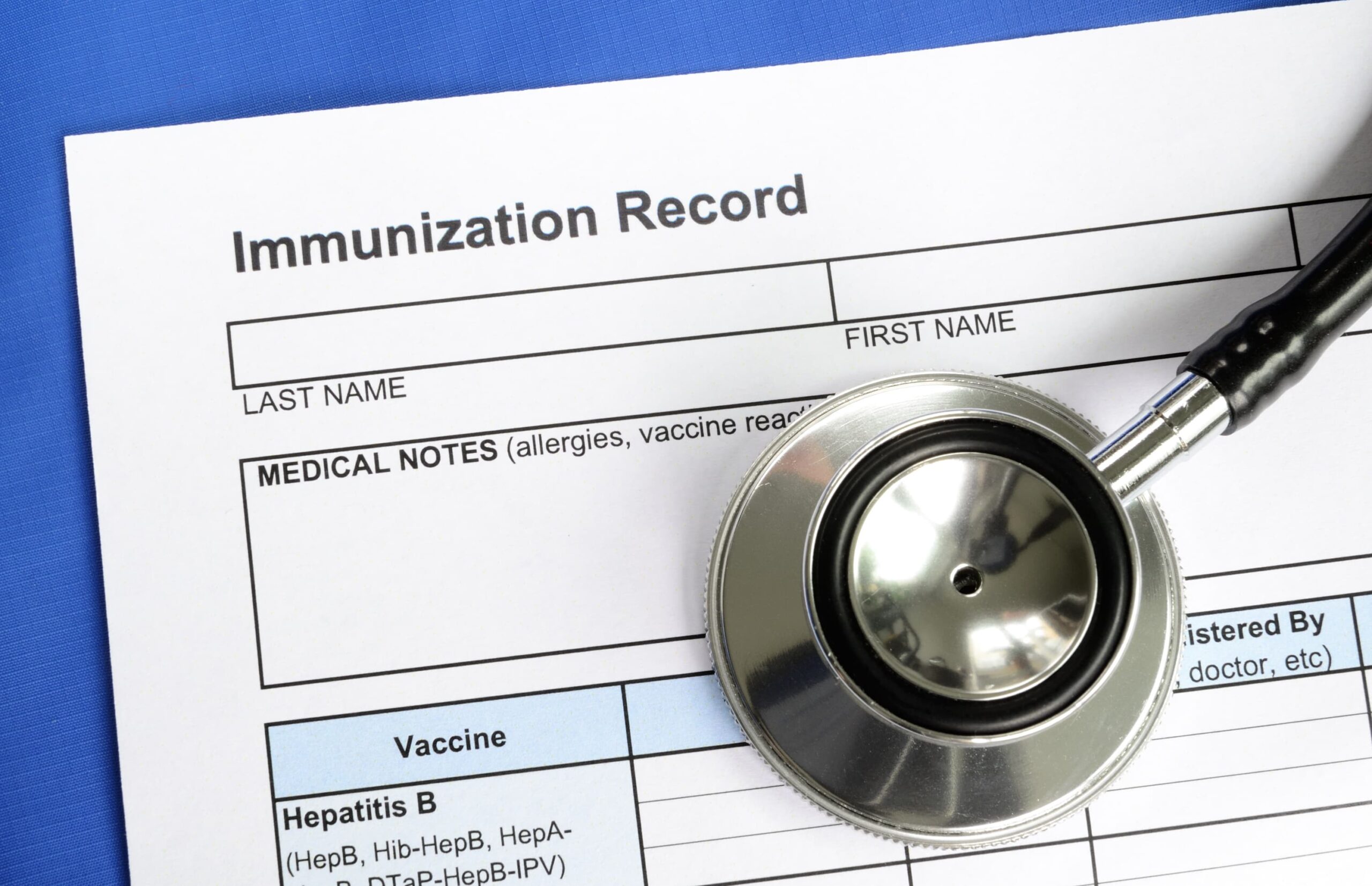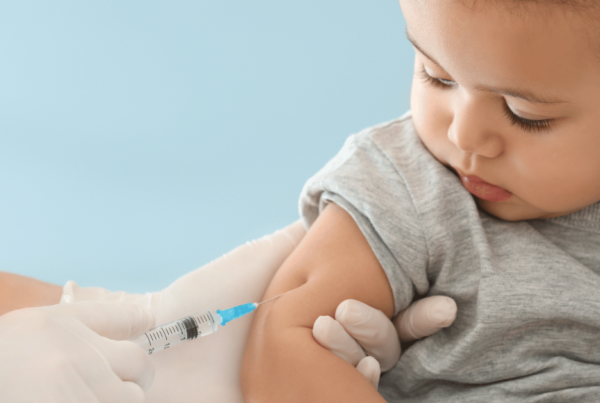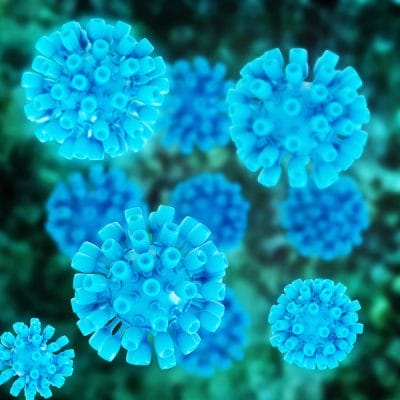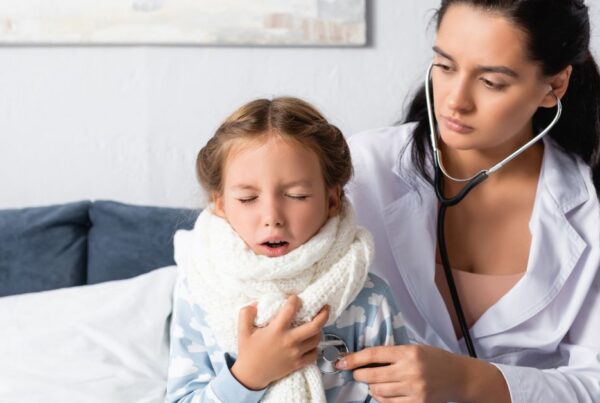- What Is Pneumococcal Disease?
- How Does Pneumococcal Disease Spread?
- Pneumococcal Disease Symptoms
- Groups At Increased Risk For Complications
- Conventional Treatment For Pneumococcal Disease
- Pneumococcal Vaccines
- When Are Pneumococcal Vaccines Given?
- Efficacy Of The Pneumococcal Conjugate Vaccines (PCVs)
- Ingredients In the Pneumococcal Vaccines
- Pneumococcal Vaccine Adverse Reactions
- Who Should Not Get A Pneumococcal Vaccine?
- Controversy & The Pneumococcal Vaccine
- Bottom Line: Pneumococcal Vaccination
What Is Pneumococcal Disease?
Pneumococcal disease is a condition caused by the bacteria Streptococcus pneumoniae. This bacteria can live unproblematically in the body for some people, but in others it can lead to infections ranging from ear infections and sinus issues to more serious problems like pneumonia, sepsis, and meningitis (1).
With over 100 known strains, pneumococcus is a normal part of the microbiome in 20–60% of children and 5-10% of adults. Being a carrier is common and usually harmless, rarely leading to illness unless the body’s defenses are already weakened (2).
How Does Pneumococcal Disease Spread?
Pneumococcal disease spreads through respiratory droplets, tiny particles released when someone coughs, sneezes, or talks. These droplets carry the bacteria Streptococcus pneumoniae, which can travel into the nasal passages or lungs and colonize, leading to carrier status, or they may take hold in greater numbers and lead to infection, depending on the body’s defenses and overall terrain.
Pneumococcal Disease Symptoms
Pneumococcus can cause different infections and symptoms. Generally, pneumococcal disease symptoms are similar to other bacterial infection symptoms, usually affecting the same areas (3).
Symptoms of pneumococcal pneumonia in infants & kids (3):
- Cough
- Chest pain
- Fever & chills
- Rapid breathing or difficulty breathing
Symptoms of pneumococcal meningitis in infants & kids (3):
- Headache
- Photophobia (light sensitivity)
- Stiff neck
- Fever
- Confusion
- Low alertness (infants)
- Problems with feeding (infants)
- Vomiting (infants)
Symptoms of pneumococcal bacteremia (blood infection) (3):
- Fever & chills
- Low alertness
Symptoms of pneumococcal otitis media (middle ear infection) (3):
- Ear pain
- Red & swollen ear drum
- Fever
- Sleepiness
Symptoms of pneumococcal sinusitis (sinus infection) (3):
- Headache (worse when leaning forward)
- Facial pain and/or pressure
- Bad breath
- Cough
- Post-nasal drip (mucus running down the back of the throat from the sinuses)
- Runny or stuffy nose
- Sore throat
Groups At Increased Risk For Complications
As with all vaccine preventable conditions, there are some groups at increased risk of complications. The CDC lists the following as risk factors for pneumococcal disease & severe infections (2):
- Children under 5 and adults over 65
- Alaska Native people
- African American people
- Certain American Indian people
- Children attending group childcare
- Alcoholism
- Cerebrospinal fluid leak
- Chronic heart, liver, kidney, or lung disease
- Cigarette smoking
- Cochlear implant
- Diabetes
- Immunocompromised condition
Note about infants: In the first 3-6 months of life, infants gain some protection from their mother’s antibodies, transferred through the placenta and breast milk (4). However, this protection isn’t absolute, and as it diminishes, children between 6 months and 5 years are at the highest risk for pneumococcal disease. This is a time when their immune systems are still developing, leaving them more susceptible to serious infections, though the disease can occur at any age (1,4).
Conventional Treatment For Pneumococcal Disease
Because pneumococcal disease is caused by a bacteria, antibiotics are used to treat it. Antibiotic resistance is a growing concern with some strains of pneumococcus. Antibiotic testing can help doctors determine which types of antibiotics will be most effective (1,5).
Supportive care is also required, which can often be done at home for mild symptoms, but in serious cases hospitalization may be needed (1).
Pneumococcal Vaccines
There are currently four pneumococcal vaccines licensed for use in the United States. Three of them are Pneumococcal Conjugate Vaccines (PCVs) and one is a Pneumococcal Polysaccharide Vaccine (PPSV). The differences are described below.
Note: You’ll notice that there are numbers after PCV or PPSV for each different vaccine: these numbers refer to the number of strains of pneumococcus that are covered by each vaccine. For example, PCV15 covers 15 different strains.
Pneumococcal Conjugate Vaccines (PCVs)
Pneumococcal Conjugate Vaccines (PCVs) contain pieces of the Streptococcus pneumoniae bacteria’s sugar coating (polysaccharides) chemically linked (conjugated) to a protein. This protein helps immune systems, especially in young children, to recognize and respond more effectively to the bacteria. These include:
Vaxneuvance (PCV15)
- Covers 15 strains
- Approved for ages 6 weeks+
Prevnar 20 (PCV20)
- Covers 20 strains
- Approved for ages 6 weeks+
CAPVAXIVE (PCV21)
- Covers 21 strains
- As of January 2024, CAPVAXIVE is approved for ages 18+ years; however, pediatric clinical trials are underway.
Pneumococcal Polysaccharide Vaccine (PPSV)
The Pneumococcal Polysaccharide Vaccines (PPSV) contains only the polysaccharides from the bacterial surface without being linked to a protein. This design stimulates a different part of the immune system and is less effective in young children under 2 years old. This vaccine isn’t part of the standard schedule, but it is often recommended for children over two who have conditions that increase their risk for severe pneumococcal disease (6). There is only one PPSV approved in the United States:
Pneumovax 23 (PPSV23)
- Covers 23 strains
- Approved for everyone aged 50+ years, and those aged 2+ years if at increased risk
When Are Pneumococcal Vaccines Given?
The current CDC schedule recommends PCV15 or PCV20 for children under 5. They should get 4 doses in total at:
- 2 months
- 4 months
- 6 months
- 12-15 months
Some children may have started with an earlier PCV (PCV13) and can finish their vaccination schedule with PCV15 or PCV20. See the standard CDC schedule here: Child and Adolescent Immunization Schedule by Age.
Note: If you choose to work with your doctor to create a delayed or alternate schedule, you should know that starting pneumococcal vaccination at different ages means that a different number of doses are required. For those starting at 6 months of age, 3 doses total are required; for those starting at 12 months of age, 2 doses total are required; and for those starting after 24 months of age, only 1 dose is needed.
For a full breakdown of doses required at different ages, see this resource from the CDC: Catch-Up Guidance for Healthy Children 4 Months through 4 Years of Age: Pneumococcal Conjugate Vaccine.
Additional vaccination with PPSV23 is decided on a case-by-case basis. Speak with your doctor for details about your individual child if you believe they may have a risk factor that increases their vulnerability (6).
Efficacy Of The Pneumococcal Conjugate Vaccines (PCVs)
Here is a breakdown of the efficacy of an early pneumococcal vaccine (PCV7) in children according to the research (7):
- 89% reduction of invasive pneumococcal disease* caused by the strains covered by the vaccines
- 63-74% reduction in invasive disease caused by any pneumococcal strain
- 55% reduction in acute otitis media (ear infection) for the strains targeted by the vaccines and 29% overall reduction in otitis media from any strain
- 29-32% reduction in x-ray confirmed pneumonia
*Invasive pneumococcal diseases are the most serious types of infections that pneumococcus causes, like meningitis, pneumonia, blood infections, etc. This class of infections doesn’t include more minor infections like bronchitis or ear infections.
We don’t yet have this information for the vaccines currently in use (PCV15 and PCV20) because they are newer, and this data takes years to collect and analyze. PCV15 & PCV20 were licensed based on non-inferiority studies (basically studies that show they are just as safe and effective as PCV13), which are described in the package inserts (8). This is discussed further in the Controversy section below.
FAQ: How Effective Is A Partial Vaccination Series?
Getting even one dose of the vaccine may confer some protection, but likely not as much as the full series.
How Long Does Protection Last?
The pneumococcal vaccine is thought to provide lifelong protection against the strains that it covers. Later in life booster vaccines are sometimes recommended because of changes in health status, such as developing a medical condition or starting a treatment that decreases immune function.
Read more about the shifting vaccine strains in the Controversy section below.
Ingredients In the Pneumococcal Vaccines
- Pneumococcal capsular polysaccharides from the following Streptococcus pneumoniae serotypes: 1, 3, 4, 5, 6A, 6B, 7F, 9V, 14, 18C, 19A, 19F, 22F, 23F, and 33F
- CRM197: Each serotype is conjugated to the carrier protein CRM197, a non-toxic variant of diphtheria toxin, produced using recombinant technology in Pseudomonas fluorescens
- Aluminum phosphate (125 mcg per dose): Enhances the immune response
- L-histidine (1.55 mg): Acts as a buffer
- Polysorbate 20 (1 mg): A surfactant to stabilize the vaccine
- Sodium chloride (4.50 mg): Maintains isotonicity
- Pneumococcal capsular saccharides from the following Streptococcus pneumoniae serotypes: 1, 3, 4, 5, 6A, 6B, 7F, 8, 9V, 10A, 11A, 12F, 14, 15B, 18C, 19A, 19F, 22F, 23F, and 33F
- CRM197: Each serotype is conjugated to the carrier protein CRM197, a non-toxic variant of diphtheria toxin, produced from Corynebacterium diphtheriae strain C7 (β197)
- Aluminum phosphate (125 μg per dose): Enhances the immune response
- Polysorbate 80 (100 μg): A surfactant to stabilize the vaccine
- Succinate buffer (295 μg): Maintains the vaccine’s pH
- Sodium chloride (4.4 mg): Maintains isotonicity
- Pneumococcal capsular polysaccharides from Streptococcus pneumoniae serotypes: 3, 6A, 7F, 8, 9N, 10A, 11A, 12F, 15A, 15B (de-O-acetylated), 16F, 17F, 19A, 20A, 22F, 23A, 23B, 24F, 31, 33F, and 35B
- CRM197: Each serotype is conjugated to the carrier protein CRM197, a non-toxic mutant of diphtheria toxin, produced from Corynebacterium diphtheriae C7, expressed recombinantly in Pseudomonas fluorescens
- L-histidine (1.55 mg): A buffering agent to maintain stability
- Polysorbate 20 (0.50 mg): A surfactant to stabilize the vaccine
- Sodium chloride (4.49 mg): Maintains isotonicity
- Purified capsular polysaccharides from Streptococcus pneumoniae serotypes: 1, 2, 3, 4, 5, 6B, 7F, 8, 9N, 9V, 10A, 11A, 12F, 14, 15B, 17F, 18C, 19F, 19A, 20, 22F, 23F, and 33F. (Each serotype is present at 25 micrograms per dose.)
- Isotonic saline solution: Maintains the proper balance of salts to match the body’s fluids
- Phenol (0.25%): Used as a preservative to prevent contamination
Pneumococcal Vaccine Inserts
- Vaxneuvance (PCV15)
- Prevnar 20 (PCV20)
- CAPVAXIVE (PCV21)
- Pneumovax 23 (PPSV23)
Pneumococcal Vaccine Adverse Reactions
Pneumococcal vaccines cause a variety of adverse reactions. While minor reactions are very common, serious adverse reactions are rare.
What follows is an overview of usual vaccine reactions to pneumococcal vaccines. Check each individual package insert for more details about each individual vaccine.
Commonly Reported Adverse Reactions:
Children Under 2 Years of Age:
- Irritability
- Drowsiness
- Pain, redness, or swelling at the injection site
- Fever (≥100.4°F, 38.0°C)
- Decreased appetite
Children Over 2 Years of Age:
- Pain, redness, or swelling at the injection site
- Fatigue
- Muscle pain
- Headache
Rare Serious Adverse Reactions
Serious adverse events are rare and may include:
- Severe Allergic Reactions (Anaphylaxis): Symptoms include difficulty breathing, swelling, and hives. Immediate medical attention is required.
- Febrile Seizures: When pneumococcal vaccine is given alongside the flu vaccine, there’s a slightly increased risk of febrile seizure (9).
- Injection Site Hypersensitivity: Redness, swelling, or pain at the injection site. Severe cases may require medical evaluation.
- Apnea: Apnea may occur when pneumococcal vaccine is given to premature infants. Check in with your healthcare provider for individualized guidance.
Post Market Surveillance
Post market surveillance is ongoing research into the safety and efficacy of vaccines after they enter the market and are put into broader use. This ongoing research helps to uncover more rare side effects and patterns.
Note: PCV15, PCV20, and PCV21 currently in use are relatively new, and therefore, post-market surveillance data is not yet available. Based on research so far, they are expected to have side effects similar to PCV13 (no longer in use). Therefore, we provide post-market surveillance data for PCV13 below. We also provide post market data for PPSV23.
PCV13 Post Market Surveillance
Post-market surveillance of PCV13 using data from SAEFVIC — a passive surveillance system in Victoria, Australia — found that adverse events following immunization (AEFI) were consistent with expectations based on clinical trials. During the study period, the reporting rate for serious AEFI with PCV13 was 25.28 per 100,000 doses. Hospitalizations were the most common serious events, primarily due to fever (either alone or with rash or infective symptoms), intussusception, or apnea. There was one report of anaphylaxis following PCV13 administration, and seizures were the most frequently reported medically significant AEFI where hospitalization was not required (10).
Additionally, one death was reported in a child who had received PCV13 along with other vaccines two weeks prior. A causality assessment determined the cause of death — cardiac arrest from myocarditis — was unrelated to vaccine administration (10).
PPSV23 Post Market Surveillance
Post Market Surveillance conducted using VAERS reports from 1990-1999 found that the rates of adverse events reported during the clinical trials (detailed in the package insert) are consistent with what happened once the vaccine was in use. The rate of serious adverse events following PPSV23 in children was 2 per 100,000 and included things like life-threatening illness, hospitalization, permanent disability, and death. An adverse event occurring after a vaccine doesn’t necessarily mean that the vaccine caused it; this type of research is conducted to explore that possibility, and it was the conclusion of the paper’s authors that the deaths were not caused by the vaccine (11).
Read the entire report here: Post-licensure safety surveillance of 23-valent pneumococcal polysaccharide vaccine in the Vaccine Adverse Event Reporting System (VAERS), 1990-2013 – PubMed
Who Should Not Get A Pneumococcal Vaccine?
According to the CDC, allergy is the main contraindication to getting a pneumococcal vaccine. Specifically, people shouldn’t get PCV15, PCV20, or PCV21 if they have had a life-threatening allergic reaction to one of the PCV vaccines or diphtheria containing vaccines (DTaP, etc.), or if they have a severe allergy to any of the vaccine ingredients (listed above).
Note that at present, PPSV23 is only licensed for those aged 2+ years who have underlying conditions that put them at increased risk for pneumococcal disease. PCV21 is not yet licensed for pediatric use (12).
The CDC recommends not getting any vaccines if there is a moderate to severe acute illness. At Dr. Green Mom, we prefer to reschedule the vaccine appointment for even minor acute illnesses when possible and when the overall risk of the vaccine-preventable infection is low.
Controversy & The Pneumococcal Vaccine
As with many vaccines, there are some questions that are confusing and may cause controversy. In this section, we do our best to explain answers to these questions and cite research so you can learn more if you’d like to.
Why Do We Keep Adding New Strains?
The addition of new strains to pneumococcal vaccines shows how Streptococcus pneumoniae changes over time and affects public health plans. Vaccines are made to protect against the strains that most often cause these diseases. However, when vaccines lower the number of certain strains, others can become more common. This is called serotype replacement. Adding new strains to vaccines is intended to help keep the vaccines effective at lowering overall rates of illness (13).
Are The New Vaccines Just As Effective As The Ones They Replaced?
The new vaccines, PCV15 and PCV20, are less immunogenic than the older PCV13 and PCV7 vaccines. This means they produce a weaker immune response. However, we don’t know if the reduced immunogenicity is enough to translate into decreased vaccine effectiveness (14).
According to the research presented in the package inserts, the new vaccines seem to work similarly to PCV13. More extensive research is needed to understand just how effective PCV15 and PCV20 are in real life compared to PCV13 (15). For now, Prevnar 20 (PCV20) and Vaxneuvance (PCV15) are the only options for routine childhood immunization in the United States.
FAQ: Does This Vaccine Reduce Risk To Those Around Me?
Yes, vaccinating your infant can help protect vulnerable people in your community and home. When children are vaccinated with pneumococcal vaccines (PCVs), they are less likely to carry and spread pneumococcus bacteria. This “indirect protection” has been shown to reduce vaccine-strain infections in adults, including older people and those with health problems (1). However, new strains of the bacteria not covered by the vaccine can still cause problems, so while the risk is lower, it’s not completely gone.
Overall, the research shows that vaccinating children directly reduces the number of infections in the vaccinated children and indirectly reduces the number of infections in other people at higher risk in their community (15).
FAQ: Does This Vaccine Shed?
No, this is not a live vaccine, and therefore there is no risk of shedding.
Bottom Line: Pneumococcal Vaccination
The pneumococcal vaccine helps protect children under 5 years of age from some infections – like ear infections, sinus infections, meningitis, and pneumonia. It doesn’t completely prevent these, but it significantly lowers the chances of getting them, especially the more serious and invasive pneumococcal infections. The vaccine also has an indirect benefit of lowering the risk of children spreading pneumococcal disease to vulnerable community members.
While pneumococcal vaccination programs have successfully reduced some types of pneumococcal disease, like pneumonia and ear infections, an unexpected community side effect has been that the strains of bacteria causing illness have changed in a process called serotype conversion. To keep up with the emerging strains, new vaccines are developed, which is why we now use PCV15, PCV20, PCV21, and PPSV23 instead of older vaccines like PCV7 and PCV13 (15).
Many children experience mild side effects, like irritability or pain at the injection site, while serious side effects are rare. People allergic to the vaccines or any ingredient shouldn’t be vaccinated.
The number of doses your child needs depends on their age. Infants who follow the vaccine schedule need 4 doses. If they start the vaccine later, the number of doses decreases. Children who start at age 6 months, need 3 doses; 12 months, need 2 doses; and 24 months, need 1 dose.
References:
- U.S. Centers for Disease Control and Prevention. (31 Oct 2024). About Pneumococcal Disease. Cdc.gov. https://www.cdc.gov/pneumococcal/about/index.html
- U.S. Centers for Disease Control and Prevention. (14 Feb 2024). Pneumococcal Disease: Causes and How It Spreads. Cdc.gov. https://www.cdc.gov/pneumococcal/causes/index.html
- U.S. Centers for Disease Control and Prevention. (6 Feb 2024). Pneumococcal Disease Symptoms and Complications. Cdc.gov. https://www.cdc.gov/pneumococcal/signs-symptoms/index.html
- Thadchanamoorthy, V., & Dayasiri, K. (2021). Review on Pneumococcal Infection in Children. Cureus, 13(5), e14913. https://doi.org/10.7759/cureus.14913
- Hanage, W. P., Fraser, C., Tang, J., Connor, T. R., & Corander, J. (2009). Hyper-recombination, diversity, and antibiotic resistance in pneumococcus. Science (New York, N.Y.), 324(5933), 1454–1457. https://doi.org/10.1126/science.1171908
- U.S. Centers for Disease Control and Prevention. (26 Jun 2024). Recommended Vaccines for Children. Cdc.gov. https://www.cdc.gov/pneumococcal/vaccines/children.html
- Pavia, M., Bianco, A., Nobile, C. G., Marinelli, P., & Angelillo, I. F. (2009). Efficacy of pneumococcal vaccination in children younger than 24 months: a meta-analysis. Pediatrics, 123(6), e1103–e1110. https://doi.org/10.1542/peds.2008-3422
- U.S. Centers for Disease Control and Prevention. (12 Sep 2024). Types of Pneumococcal Vaccines. Cdc.gov. https://www.cdc.gov/pneumococcal/vaccines/types.html
- Tse, A., Tseng, H. F., Greene, S. K., Vellozzi, C., Lee, G. M., & VSD Rapid Cycle Analysis Influenza Working Group (2012). Signal identification and evaluation for risk of febrile seizures in children following trivalent inactivated influenza vaccine in the Vaccine Safety Datalink Project, 2010-2011. Vaccine, 30(11), 2024–2031. https://doi.org/10.1016/j.vaccine.2012.01.027
- Littlejohn, E. S., Clothier, H. J., Perrett, K. P., & Danchin, M. (2015). Surveillance of adverse events following the introduction of 13-valent pneumococcal conjugate vaccine in infants, and comparison with adverse events following 7-valent pneumococcal conjugate vaccine, in Victoria, Australia. Human vaccines & immunotherapeutics, 11(7), 1828–1835. https://doi.org/10.1080/21645515.2015.1048937
- Miller, E. R., Moro, P. L., Cano, M., Lewis, P., Bryant-Genevier, M., & Shimabukuro, T. T. (2016). Post-licensure safety surveillance of 23-valent pneumococcal polysaccharide vaccine in the Vaccine Adverse Event Reporting System (VAERS), 1990-2013. Vaccine, 34(25), 2841–2846. https://doi.org/10.1016/j.vaccine.2016.04.021
- U.S. Centers for Disease Control and Prevention. (26 Oct 2024). Pneumococcal Vaccination. Cdc.gov. https://www.cdc.gov/pneumococcal/vaccines/index.html
- Izurieta, P., Bahety, P., Adegbola, R., Clarke, C., & Hoet, B. (2018). Public health impact of pneumococcal conjugate vaccine infant immunization programs: assessment of invasive pneumococcal disease burden and serotype distribution. Expert review of vaccines, 17(6), 479–493.
- De Wals, P. (2024). PCV13, PCV15 or PCV20: Which vaccine is best for children in terms of immunogenicity?. Canada communicable disease report, 50(1-2), 35–39. https://doi.org/10.14745/ccdr.v50i12a04
- Flem, E., Mouawad, C., Palmu, A. A., Platt, H., Johnson, K. D., McIntosh, E. D., Abadi, J., Buchwald, U. K., & Feemster, K. (2024). Indirect protection in adults ≥18 years of age from pediatric pneumococcal vaccination: a review. Expert review of vaccines, 23(1), 997–1010. https://doi.org/10.1080/14760584.2024.2416229
- Esposito, S., & Principi, N. (2015). Impacts of the 13-Valent Pneumococcal Conjugate Vaccine in Children. Journal of immunology research, 2015, 591580. https://doi.org/10.1155/2015/591580
Reviewed/Updated: 03/25
Content Created: 07/14









